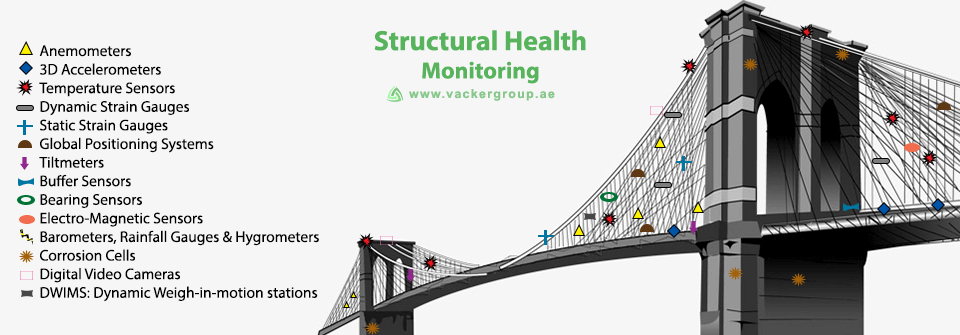The Dynamics Of Structural Health Monitoring In Civil Infrastructure
 As construction technology has evolved over the years, so has the complexity of the structures that are being built. With so much emphasis on making construction projects more efficient and cost-effective, there has been a significant increase in the use of innovative building materials and techniques. As a result, monitoring the structural health of buildings and other infrastructure is more important today than it ever has been before. Structural health monitoring (SHM) is an advanced technology that has proven to be very effective in ensuring that infrastructure remains safe and functional.
As construction technology has evolved over the years, so has the complexity of the structures that are being built. With so much emphasis on making construction projects more efficient and cost-effective, there has been a significant increase in the use of innovative building materials and techniques. As a result, monitoring the structural health of buildings and other infrastructure is more important today than it ever has been before. Structural health monitoring (SHM) is an advanced technology that has proven to be very effective in ensuring that infrastructure remains safe and functional.
SHM is a comprehensive system that collects and analyzes real-time data on a building's structural condition. The technology uses a number of sensors and other equipment to monitor different aspects of a structure's health. For example, sensors may be used to measure changes in temperature, vibration, or stress levels in various parts of the structure. This data can then be analyzed to identify potential problems before they become serious issues.
SHM can be used in a wide range of applications, including bridges, dams, tunnels, and high-rise buildings. By regularly monitoring the structural health of these types of structures, engineers and other professionals can ensure that they remain safe and structurally sound at all times. In addition, SHM can help to identify potential problems at an early stage, which can be critical in preventing damage or even collapse.
Another important benefit of SHM is that it can help to reduce maintenance costs and extend the lifespan of infrastructure. By identifying potential problems early on, engineers and other professionals can take proactive measures to address them before they become more serious. This can save a significant amount of money over the long term, as it reduces the need for expensive repairs or replacement.
Frequently Asked Questions About Structural Health Monitoring
Q: What types of sensors are used in SHM?
A: SHM systems typically use a variety of sensors, including strain gauges, accelerometers, and temperature sensors. Each type of sensor is designed to measure a specific aspect of a building's structural health.
Q: How often should SHM be performed?
A: The frequency of SHM depends on the type of structure being monitored and the level of risk associated with it. In general, high-risk structures such as bridges and dams should be monitored more frequently than lower-risk structures such as office buildings.
Q: How accurate is SHM?
A: SHM is a highly accurate technology that can detect even small changes in a structure's condition. The accuracy of the system depends on a number of factors, including the quality of the sensors and the expertise of the professionals who install and maintain the system.
Q: What happens if a problem is detected through SHM?
A: If a problem is detected through SHM, engineers and other professionals will analyze the data to determine the cause of the problem and the best way to address it. Depending on the severity of the issue, repairs may be required or additional monitoring may be necessary.
Q: How much does SHM cost?
A: The cost of SHM varies depending on a number of factors, including the size and complexity of the structure being monitored and the level of detail required in the analysis. In general, SHM can be expensive, but the cost is often outweighed by the long-term benefits of the technology.
In conclusion, structural health monitoring is an essential technology for ensuring the safety and longevity of infrastructure in today's complex construction environment. By proactively monitoring the structural health of buildings and other structures, engineers and other professionals can identify potential problems before they become serious issues. With its ability to reduce maintenance costs, extend the lifespan of infrastructure, and reduce the risk of catastrophic failure, SHM is becoming an increasingly important tool for construction professionals around the world.
References:
- "Structural Health Monitoring." Wikipedia, Wikimedia Foundation, 7 June 2021, en.wikipedia.org/wiki/Structural_health_monitoring.
- "What is Structural Health Monitoring and How is It Performed." The Constructor, 19 Jan. 2019, theconstructor.org/structures/structural-health-monitoring-shm-performance/23627/.
- "Structural Health Monitoring for Safe and Sustainable Infrastructure – An Overview." ScienceDirect, Elsevier BV, 1 May 2017, sciencedirect.com/science/article/pii/S1359836816329020.
[Data Source: https://www.vackergroup.ae/wp-content/uploads/2018/02/structural-health-monitoring.png]


Post a Comment for "The Dynamics Of Structural Health Monitoring In Civil Infrastructure"